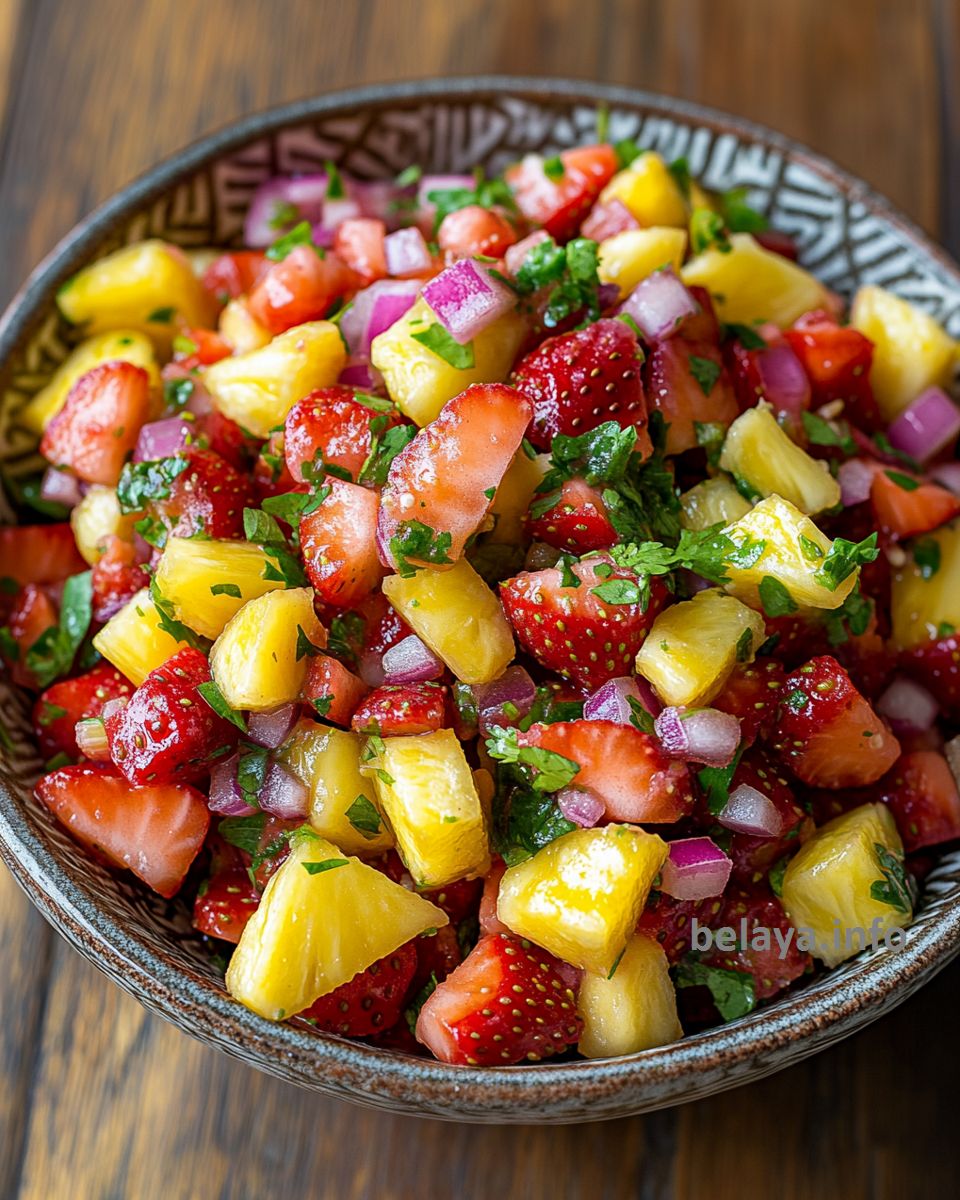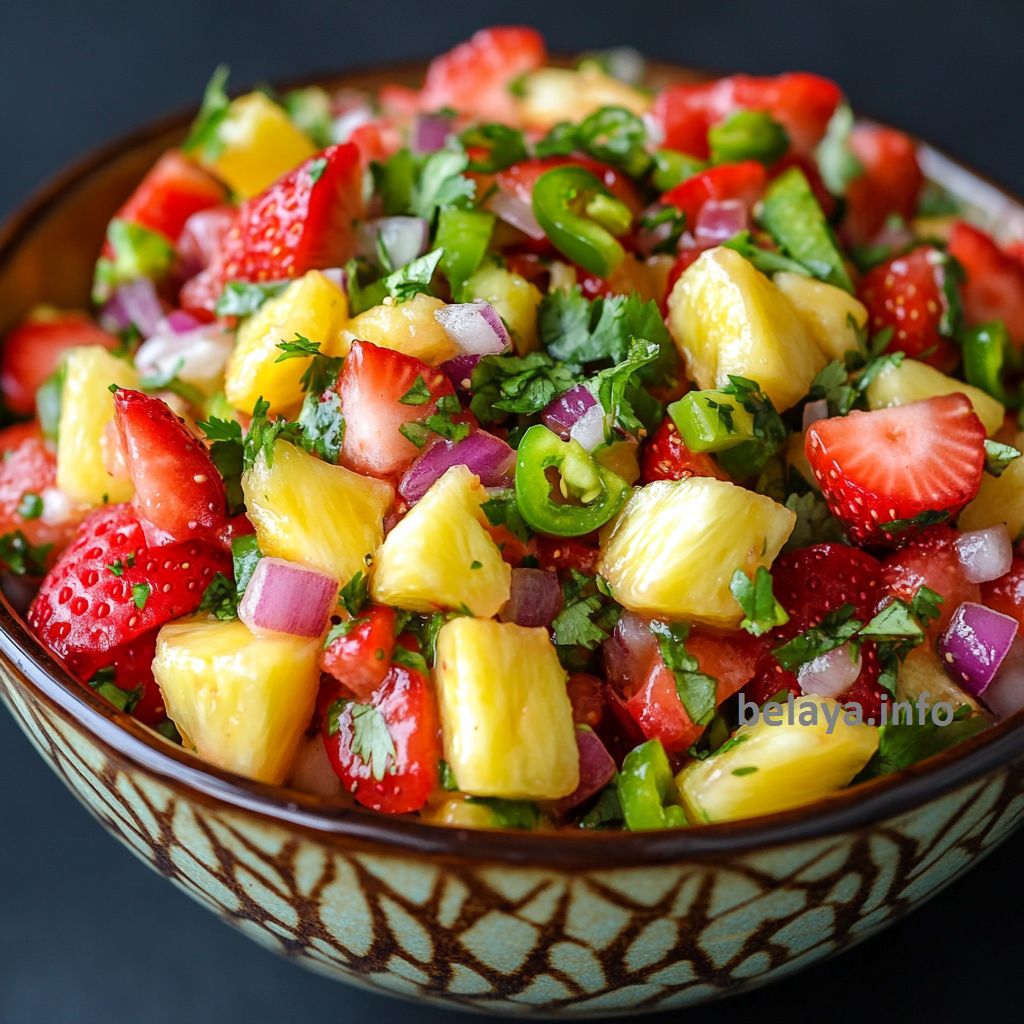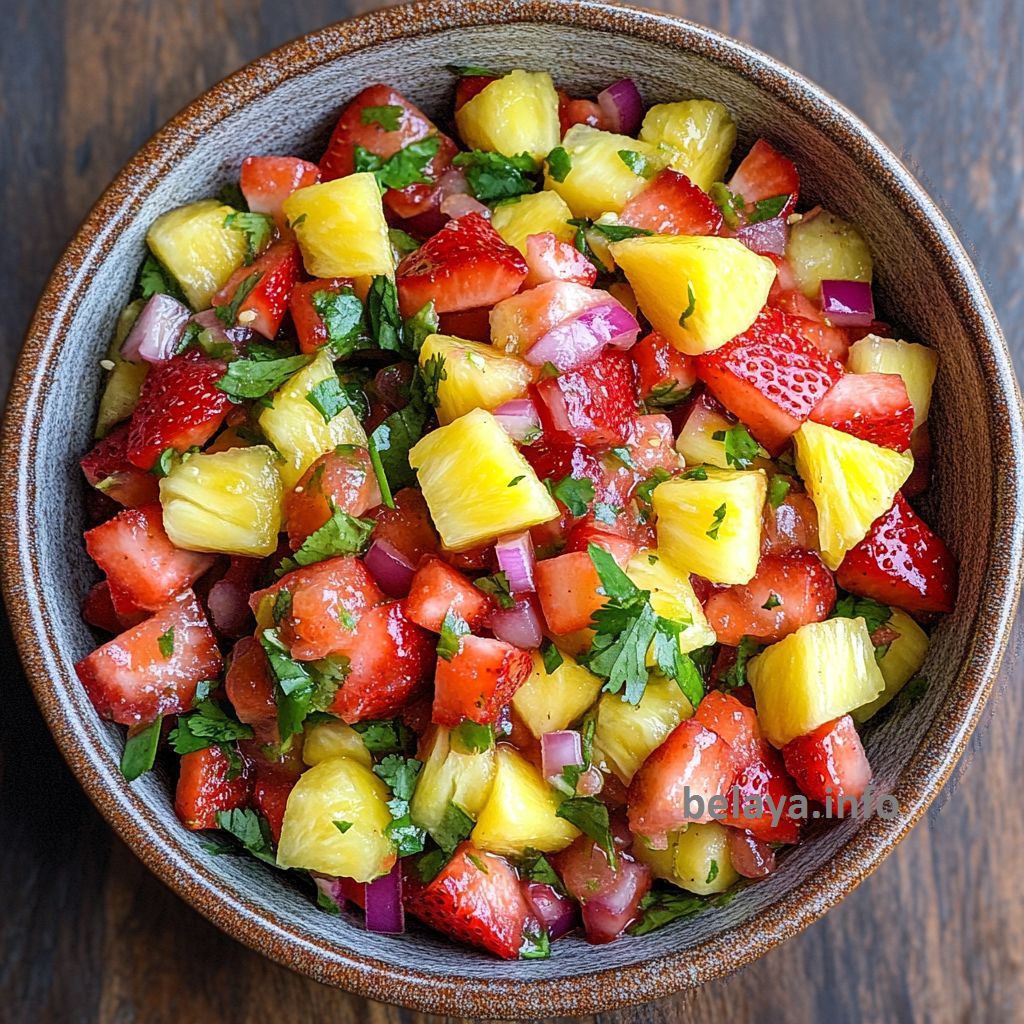Refreshing Strawberry Pineapple Salsa
Bright, juicy, and bursting with layers of flavor, this Strawberry Pineapple Salsa is a celebration of summer in every bite. The natural sweetness of ripe strawberries and tangy pineapple is perfectly balanced by the sharp bite of red onion, the herbal freshness of cilantro, and a subtle kick from jalapeño.
Finished with fresh lime juice and a pinch of salt, this salsa is both refreshing and complex—ideal as a light topping for grilled meats, a zesty companion to fish tacos, or a colorful dip served with tortilla chips.
It’s a quick, no-cook recipe that transforms simple ingredients into something truly memorable.

Why People Will Love The Refreshing Strawberry Pineapple Salsa:
A vibrant contrast of sweet and savory: The natural sugars in strawberries and pineapple are beautifully balanced by the sharpness of red onion and the brightness of lime, creating a flavor profile that’s both bold and refreshing.
Multi-dimensional freshness in every bite: Each ingredient brings its own texture and note—juicy fruit, crisp onion, cooling herbs, and a hint of heat—all working together to awaken the palate.
Naturally wholesome and guilt-free: This salsa is made entirely from fresh, raw ingredients with no added sugars or oils, making it a light, clean option for those seeking vibrant, health-conscious dishes.
Versatile enough for any occasion: It pairs equally well with grilled proteins, seafood, tacos, or as a vibrant appetizer—making it ideal for weeknight dinners, backyard cookouts, or elegant entertaining.
No cooking required, but packed with complexity: Despite its simplicity, the interplay of acidity, spice, and sweetness offers a depth of flavor that feels gourmet, yet is effortless to prepare.
A show-stopping pop of color: With its reds, yellows, and greens, this salsa is as visually appealing as it is delicious—bringing a burst of brightness to any plate or serving platter.

Key Ingredients in the Refreshing Strawberry Pineapple Salsa:
Strawberries: Juicy and slightly tart, ripe strawberries add a natural sweetness and soft texture that serve as a fruity anchor—bringing a delicate complexity and a hint of berry brightness to every bite.
Pineapple: Bold and tropical, pineapple offers firm, golden chunks of acidity and sweetness, balancing the strawberries with its vibrant tang and adding depth to the overall flavor.
Red onion: Finely chopped for just the right bite, red onion introduces a sharp, savory edge that cuts through the sweetness—creating contrast and enhancing the salsa’s freshness.
Cilantro: Herbal and aromatic, cilantro adds an earthy, citrusy lift that ties the fruity and savory elements together, grounding the salsa in a fresh, clean finish.
Jalapeño: Seeded and minced, jalapeño brings a gentle heat that lingers just enough to keep things exciting—without overwhelming the natural sweetness of the fruit.
Lime juice: Acting as the unifying element, lime juice adds brightness, acidity, and balance—elevating the entire salsa while helping preserve the vibrant colors and textures.
Salt: Just a pinch enhances every component, subtly drawing out the sweetness of the fruit and the sharpness of the onion for a well-rounded and craveable finish.

Expert Tips:
Choose perfectly ripe fruit for optimal balance: Use strawberries that are deep red and fragrant—not overly soft—for maximum flavor and structure. Pineapple should be golden and slightly yielding to pressure, which ensures it’s juicy but not watery.
Dice with intention—uniformity matters: Cut all ingredients into similar-sized, small cubes. This consistency ensures that every bite delivers a balanced mix of sweet, savory, and spicy, and prevents heavier items like pineapple from dominating the spoon.
Let it rest, but not too long: Chill the salsa for 30–60 minutes before serving to allow the flavors to meld. However, don’t let it sit too long (especially overnight), or the strawberries may release too much juice and become soft.
Layer the salt and lime juice with care: Add salt and lime gradually and taste as you go. Lime brightens the fruit, but too much can overpower the delicate strawberry. Salt enhances the savory notes and balances sweetness—but just a touch is transformative.
Add jalapeño strategically: If you’re spice-sensitive, add half the jalapeño first, then taste and adjust. To increase depth without extra heat, keep a few seeds in, or substitute with minced serrano for sharper spice.
Consider texture contrasts for serving: This salsa pairs beautifully with crunchy elements like tortilla chips or crisp tostadas. It also makes a great topping for grilled proteins like chicken, shrimp, or fish, adding coolness and zing to rich, smoky flavors.
Use it the same day for best results: While it will keep for up to 24 hours in the fridge, the salsa is at its peak within the first few hours. Serve it freshly chilled for the brightest flavor and cleanest texture.

Refreshing Strawberry Pineapple Salsa
Ingredients:
1 cup diced strawberries
1 cup diced pineapple
1/4 cup finely chopped red onion
1/4 cup chopped cilantro
1 jalapeño, seeded and minced
Juice of 1 lime
Salt to taste
Instructions:
In a medium bowl, add the diced strawberries, pineapple, red onion, cilantro, and minced jalapeño.
Squeeze the fresh lime juice over the mixture and stir gently to combine all ingredients evenly.
Season lightly with salt to enhance the flavors, tasting and adjusting as needed.
Cover and refrigerate for at least 30 minutes to let the flavors meld and develop.
Serve chilled as a topping for grilled chicken, fish tacos, or with tortilla chips.

Important Notes When Preparing Refreshing Strawberry Pineapple Salsa:
Freshness is the foundation of flavor: This salsa relies entirely on the quality of its raw ingredients. Use seasonal, ripe strawberries and a fragrant, sweet pineapple—overripe fruit can become mushy and overly sugary, while underripe fruit lacks the depth needed to balance the savory and acidic components.
Drain excess juice if needed: Strawberries and pineapple naturally release juice after being cut. If the salsa becomes too watery, it can dull the flavors and affect the texture. After chilling, you may want to gently drain or spoon off excess liquid before serving.
Salt is a flavor unlocker, not just a seasoning: Even a small pinch of salt can make the sweet notes pop and tame the acidity of lime and the bite of onion. Under-salting results in a flat flavor profile, so taste and adjust gradually.
Jalapeño adds more than just heat: Beyond spice, jalapeño introduces a green, vegetal freshness that balances the fruit. Mincing it finely ensures that it blends into the mix instead of overwhelming it in isolated bites. For bolder flavor with less heat, use roasted jalapeño or a few drops of hot sauce instead.
Red onion should be finely chopped and possibly rinsed: To avoid overpowering the other flavors, make sure the onion is finely diced. For a milder taste, soak the chopped onion in cold water for 5–10 minutes and drain before adding—this removes harsh rawness while preserving its crunch and bite.
Lime juice acts as both flavor and preservative: Not only does it brighten the salsa, but it also helps maintain color and freshness—especially preventing the strawberries from oxidizing. However, too much lime can dominate, so always taste after squeezing.
Best served within hours of making: This salsa is most vibrant within the first 2–4 hours. If made too far in advance, the fruit softens and the cilantro may lose its crispness. If storing, wait to add the cilantro until just before serving for a fresh finish.

How to Enjoy Refreshing Strawberry Pineapple Salsa After Mixing
Let It Chill—But Not Too Long
After mixing, refrigerate the salsa for 30–60 minutes. This allows the flavors to meld beautifully—fruity sweetness, citrus brightness, and gentle heat from the jalapeño all become more harmonious.
Avoid chilling too long (beyond 6–8 hours), as the fruit may become overly soft and release too much juice, diluting the flavor and affecting texture.
Serve It Cold or Cool
This salsa is best served cool, not icy, to preserve its natural juiciness and freshness. Take it out of the fridge 10–15 minutes before serving to bring it to peak taste.
Ways to Enjoy It
As a topping:
Spoon over grilled chicken, fish tacos, shrimp skewers, or seared pork chops for a tropical, refreshing contrast.
As a dip:
Serve with crispy tortilla chips, plantain chips, or pita crisps for a sweet-savory snack or party starter.
As a fresh side:
Plate alongside rice bowls, grilled vegetables, or quinoa salads to brighten up heartier dishes.
As a light appetizer:
Fill endive leaves, cucumber cups, or mini tostada shells with salsa for a colorful, bite-sized starter.
Pro Tip: Add-On Ideas
Stir in diced avocado just before serving for added creaminess.
Add a few pomegranate seeds or mango chunks for a sweet-tart burst.
A small drizzle of honey or agave can enhance the fruit if it’s slightly underripe.
Nutrition Information
Per serving assuming the recipe yields about 4 servings:
Calories: 48 kcal | Total Fat: 0.3 g | Saturated Fat: 0.04 g | Monounsaturated Fat: 0.02 g | Polyunsaturated Fat: 0.05 g | Cholesterol: 0 mg | Sodium: 75–130 mg (depending on salt added) | Total Carbohydrates: 12.1 g | Dietary Fiber: 2.2 g | Sugars: 8.6 g | Protein: 0.9 g
Note: Values are approximate and will vary based on exact produce ripeness, cutting size, and seasoning preferences.

Frequently Asked Questions:
Can I make this salsa ahead of time?
Yes, but it’s best enjoyed within 2–4 hours of preparation.
The fruit will begin to release juices and soften over time.
If you need to make it earlier, store it covered in the refrigerator and stir in the lime juice and cilantro just before serving for maximum freshness.
Can I use frozen strawberries or pineapple?
It’s not recommended.
Frozen fruit releases too much moisture when thawed, which dilutes flavor and results in a watery, mushy texture.
Fresh fruit delivers the bright, crisp texture that makes this salsa refreshing.
Is there a way to reduce the heat if I’m sensitive to spice?
Absolutely. Use half a jalapeño, or remove the seeds and inner membranes completely.
You can also substitute with a small amount of mild green bell pepper for color and crunch without the heat.
What dishes does this pair well with?
This salsa is extremely versatile—it pairs beautifully with grilled chicken, shrimp, or fish tacos, and can also be served with tortilla chips, bruschetta toasts, or even as a fresh topping for grilled pork or tofu.
How can I prevent the strawberries from becoming too soft?
Use just-ripe strawberries, not overly soft ones, and add the salt and lime juice shortly before serving.
Both salt and acid draw moisture from the fruit, so timing is key to maintaining their structure and color.
How finely should I chop the ingredients for best texture?
Aim for a uniform, small dice (¼-inch or smaller).
This ensures each bite delivers a balanced mix of sweet, savory, and spicy.
It also improves the visual appeal and makes the salsa easier to scoop or spoon over other dishes.
How do I keep the salsa from becoming too watery?
After dicing, let the strawberries and pineapple sit briefly on paper towels to absorb excess juice.
Also, add salt and lime juice just before serving, as both draw out moisture and can cause the fruit to soften too quickly.
Can I adjust the heat level without losing flavor?
Yes. For less heat, use only part of the jalapeño or remove all seeds and membranes.
For more depth without extra spice, try adding a pinch of smoked paprika or a few drops of hot sauce to enhance flavor complexity without overwhelming heat.
When should I add the cilantro?
Add cilantro at the very end, just before serving.
This preserves its vibrant green color and fresh, herbal flavor.
If added too early, it can wilt and lose its brightness during refrigeration.
What’s the best way to serve this salsa?
Serve it chilled for optimal contrast and refreshment.
It works best as a topping for grilled meats or fish, or as a colorful dip with tortilla chips.
For elegant presentation, try spooning it over toasted baguette slices or inside endive leaves for a bite-sized appetizer.